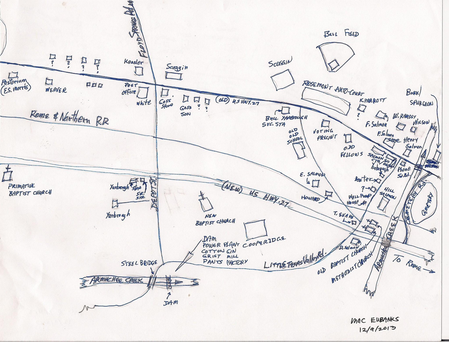 Armuchee Creek Near the Site of the Old Power Mill Armuchee Creek Near the Site of the Old Power Mill Sam Burnham - Curator Armuchee Creek creeps through the Appalachian foothills as it has for thousands of years. These hill are old, the eroded remnants of their former selves. The locals will tell you that Armuchee is Cherokee for “land of many fish” or something to that effect. When the Cherokee lived here the creek provided water, food, and transportation. After the Cherokee removal on the Trail of Tears, this area was resettled and the creek remained important. Some 50-60 years after the last Cherokee left the creek found a new use. In the old village, what locals call “Downtown Armuchee,” stood a grist mill, a pants factory, a cooperage, and a cotton gin. All of these operations were powered by an early-technology electric generator that was powered by the creek. A small dam ponded the creek near the iron bridge where Little Texas Valley Road crosses the creek. The mill harnessed the power of the pond overflow to turn the little generator and produce electricity. The amount of power generated was more than these small industries needed and several homes were added to the local grid. The residents of this small village were reading by electric light two decades before the TVA broke ground on their first hydroelectric dam. The evidence of this fact is confirmed in a May 1916 publication of the Electrical Review and Western Electrician. The report in that journal was that the Armuchee Water Mill was unfortunately destroyed by fire. That sounds like a strike against local power but this was early technology and fire was a widespread problem in structures of all sorts. While fire is and will remain a threat, new technology and practices have greatly reduced that threat. Present technology also offers redundancy that make accidents less devastating. In 1916 there was little more than lighting that would use electricity in a home. These days almost everything uses electricity. But modern technology has created energy efficient appliances and devices. Major utility companies have reported dips in demand as people choose LED lighting and other energy saving options. Modern technology also produces a lot more electricity than 1916 technology did.  Local Historian Mac Eubanks Made This Map Detailing the Old “Downtown” Armuchee on the Old Micro-Grid. Local Historian Mac Eubanks Made This Map Detailing the Old “Downtown” Armuchee on the Old Micro-Grid. Generating electricity has become more efficient as well. Most notably, solar panels have become more efficient and effective while also becoming more affordable. One kilowatt/hour of solar power is now cheaper than the same amount of coal generated electricity. This has made solar a viable option for use in community power. More recently, the South Georgia town of Plains, longtime home of former President Jimmy Carter, now generates half of its needed electricity by a local solar farm. Let me specify that Plains is a small town. I’m not advocating running the whole state this way. There is still a real need for large scale power generation in places like Plant Bowen, Plant Vogtle, and by TVA dams throughout their system. But for small towns or even designated neighborhoods in big cities, community power is a revolutionary opportunity. By generating power locally and establishing a micro-grid, like Armuchee at the turn of the 20th Century, we can lower our costs and build in resilience to protecting ourselves from disruptions. Armuchee historically used the creek and hydroelectric generation. That is possibly still an option. But in The South we also have an abundance of sunshine. Solar panels, partnered with the latest in storage units could make the needed power and store it for nighttime or in the case of (literally) a rainy day. The resilience comes into play with the local micro-grid. For example, a few years back when a tornado cut through the Berry College and Glenwood communities, serious damage was caused to transmission infrastructure. The Armuchee area was without power for days. Had the old micro-grid still been active no loss of power would have occurred in the old neighborhood. That area was barely impacted by the storm. The mill and the grid would have remained intact. Even during the Blizzard of ‘93, a local crew could have hooked up individual homes in a day and power would have been restored quickly. Even a mechanical malfunction at the mill would be backed up by the storage units until repairs are made. Local power can be a game changer for small towns. Poorer communities within cities can also benefit from this idea. The best part is that our local EMCs as well as the TVA or The Southern Company can get in on this. They need to hear from customers or members who are interested in bringing this sort of project to their neighborhoods. Local power lowers costs while building resilience and investment in our communities. There is no downside to the proposition. By revisiting an old idea we can open possibilities for the future. We can build a future with better opportunities for businesses and residents. We can power healthy and sustainable economic growth while fostering a sense of community. Local power is the best way to illuminate the way forward.
0 Comments
Leave a Reply. |
Sam B.Historian, self-proclaimed gentleman, agrarian-at-heart, & curator extraordinaire Social MediaCategories
All
Archives
November 2022
|




 RSS Feed
RSS Feed
